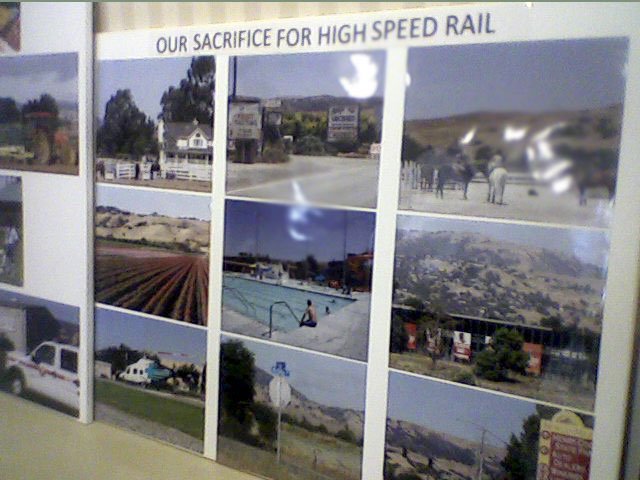More than 100 people showed up to the Hilton Garden Inn on
Monday to view displays of potential routes for the future
California High-Speed Rail project.
More than 100 people showed up to the Hilton Garden Inn on Monday to view displays of potential routes for the future California High-Speed Rail project.
Although the public information meeting focused on possible rail routes that the California High-Speed Rail Authority already had announced, it created a venue for South County residents to ask questions, vent frustrations and share information.
“We’re no longer spots and dots on a map,” said Yvonne Sheets-Saucedo, who pointed to a photo display she had assembled of homes and landmarks that would be demolished if a U.S. 101 rail alignment were implemented.
Sheets-Saucedo was one of dozens of rural South County residents who expressed fears that the high-speed rail project would ruin their rural lifestyle and in some cases destroy their properties.
The $45-billion, 800-mile California High-Speed Rail system, expected to begin full operations in 2020, is slated to have routes from San Diego to Sacramento and to the Bay Area, transporting passengers at speeds of up to 220 mph. A 123-mile stretch from Merced to San Jose would run through the Pacheco Pass and will likely include a station in Gilroy.
Rail officials say it will be about a year before a draft environmental impact report comes out with more precise information on rail routes impacts. However, many attendees already had developed theories of their own.
Sheets-Saucedo and a few others reasoned that an alignment along Monterey Street in Gilroy would be impossible because of its proximity to the Union Pacific right of way. In the past, UP has adamantly opposed the high-speed rail project’s potential proximity to its own operations, describing a Monterey Street alignment as a safety hazard. As a result, Sheets-Saucedo felt it was inevitable that the ultimate alignment would run along U.S. 101 and pass through rural areas east of Gilroy. She also speculated that the train would run on an aerial route because the eastern alignment stands on a flood plain.
Several people who had properties along that route said they were not pleased with it, and some took issue with the project in general.
“There’s a groundswell movement that’s building against this,” said Rucker Avenue resident Mary Anne Giacalone.
Giacalone said an eastern route would run through her neighbor’s barn. She anticipated that her neighbor would be compensated through eminent domain but that she would not receive any compensation even though she would suffer from noise impacts and blowing debris.
Sheets-Saucedo’s photo display portrayed other landmarks that also may be impacted if an eastern route were chosen. Those included the CalFire station on Masten Avenue, Saint Louise Regional Hospital and the Andy’s Orchard fruit stand in Morgan Hill.
Peterson Tractor Co. and See Grins RV in San Martin also would likely be affected, said Sylvia Hamilton, who heads up the San Martin Neighborhood Alliance.
Some rural residents as well as the Santa Clara County Farm Bureau advocated for a route that would go through downtown Gilroy along Monterey Street, but that would create impacts of its own. Connie Rogers, president of the Gilroy Historical Society, feared that the downtown route might affect South Valley Middle School and Rebekah’s Children’s Services.
Project representatives said it was still too early in the process to determine where the rail line would go. The high-speed rail authority released a report on various alternatives earlier this month that only eliminated one potential route – a Gilroy Station Loop that had included two tracks running along U.S. 101 and two running through downtown. Other previously discussed options along the Monterey Highway-Union Pacific Railroad corridor and along U.S. 101 between Gilroy and Morgan Hill remain.
“We would not be carrying forward any options at this point if we did not think it was feasible to move forward,” said Dan Leavitt, deputy director of the California High-Speed Rail Authority.
Although project representatives said they heard many concerns about property value impacts Monday, Leavitt said that people were not considering the potential benefits that a downtown train station could have on Gilroy.
Both he and Dave Mansen, a regional project manager for the project, also sought to clarify parking concerns. At the very most, the station would need to accommodate 6,600 vehicles, and there is a chance all that parking would not be needed until 2035, they said. In addition, all parking for the station probably would not be placed in the same location, they said.
Regardless of how the project is ultimately implemented, it would have a huge impact on Gilroy, City Administrator Tom Haglund said.
If the rail line runs along Monterey Street, it would have a dramatic effect on downtown, Haglund said. If the tracks ran east of U.S. 101, it would impact how that area eventually develops, he said.
“I think this is going to really change the face of Gilroy, whatever alignment is chosen,” Haglund said.
He urged residents to provide as much input as possible. The City Council will talk abut creating a community engagement process during its July 19 meeting to get more people involved, he said.
High-speed rail officials also said they wanted to hear from people, and they said they were glad to see the large turnout on Monday.
“There’s nothing like a line on a map to get good input from people,” said Gary Kennerley, regional project manager for the high-speed rail project.














